Enhanced Carbofuran Degradation Using Immobilized and Free Cells of Enterobacter sp. Isolated from Soil
Abstract
1. Introduction
2. Results and Discussions
2.1. Isolation and Identification
2.2. Degradation Studies for Enterobacter sp. Strain BRC05 by Comparison between Immobilized Cell and Freely-Suspended Cell
2.3. Effect of Heavy Metals on the Degradation of Carbofuran by Enterobacter sp. Strain BRC05
2.4. Effect of Mercury (Hg) on the Degradation of Carbofuran by Immobilized Cells of Enterobacter sp.
2.5. Reusability of Gellan Gum Beads
3. Material and Methods
3.1. Chemicals and Medium
3.2. Analytical Technique
3.3. Sampling
3.4. Isolation of Carbofuran-Degrading Bacteria
3.5. Immobilization of Bacterial Strain
3.6. Comparison of the Biodegradation of Carbofuran by Freely Suspended and Immobilized Cells
3.7. Effect of Heavy Metals on the Degradation of Carbofuran by Enterobacter sp. BRC05
3.8. Reusability of Gellen Gum Beads
4. Conclusions
Author Contributions
Funding
Conflicts of Interest
References
- Tien, C.J.; Huang, H.J.; Chen, C.S. Accessing the Carbofuran Degradation Ability of Cultures From Natural River Biofilms in Different Environments. CLEAN Soil Air Water 2017, 45, 1600380. [Google Scholar] [CrossRef]
- Rahaman, M.M.; Islam, K.S.; Jahan, M. Rice Farmers’ Knowledge of the Risks of Pesticide Use in Bangladesh. J. Health Pollut. 2018, 8, 181203. [Google Scholar] [CrossRef]
- Alvarez, A.; Saez, J.M.; Davila Costa, J.S.; Colin, V.L.; Fuentes, M.S.; Cuozzo, S.A.; Benimeli, C.S.; Polti, M.A.; Amoroso, M.J. Actinobacteria: Current research and perspectives for bioremediation of pesticides and heavy metals. Chemosphere 2017, 166, 41–62. [Google Scholar] [CrossRef]
- Skrbic, B.D.; Marinkovic, V. Occurrence, seasonal variety of organochlorine compounds in street dust of Novi Sad, Serbia, and its implication for risk assessment. Sci. Total Environ. 2019, 662, 895–902. [Google Scholar] [CrossRef] [PubMed]
- Mansano, A.S.; Moreira, R.A.; Dornfeld, H.C.; Diniz, L.G.R.; Vieira, E.M.; Daam, M.A.; Rocha, O.; Seleghim, M.H.R. Acute and chronic toxicity of diuron and carbofuran to the neotropical cladoceran Ceriodaphnia silvestrii. Environ. Sci. Pollut. Res. Int. 2018, 25, 13335–13346. [Google Scholar] [CrossRef] [PubMed]
- Onunga, D.O.; Kowino, I.O.; Ngigi, A.N.; Osogo, A.; Orata, F.; Getenga, Z.M.; Were, H. Biodegradation of carbofuran in soils within Nzoia River Basin, Kenya. J. Environ. Sci. Health B 2015, 50, 387–397. [Google Scholar] [CrossRef] [PubMed]
- Wang, X.; Lu, L.; Yao, M.; Zhang, H.; Bao, J. Degradation of Carbofuran in Contaminated Soil by Immobilized Laccase. Polish J. Environ. Stud. 2017, 26, 1305–1312. [Google Scholar] [CrossRef]
- Schafer, R.B.; Caquet, T.; Siimes, K.; Mueller, R.; Lagadic, L.; Liess, M. Effects of pesticides on community structure and ecosystem functions in agricultural streams of three biogeographical regions in Europe. Sci. Total Environ. 2007, 382, 272–285. [Google Scholar] [CrossRef]
- Laocharoen, S.; Plangklang, P.; Reungsang, A. Selection of support materials for immobilization of Burkholderia cepacia PCL3 in treatment of carbofuran-contaminated water. Environ. Technol. 2013, 34, 2587–2597. [Google Scholar] [CrossRef]
- Singh, D.K. Biodegradation and bioremediation of pesticide in soil: Concept, method and recent developments. Indian J. Microbiol. 2008, 48, 35–40. [Google Scholar] [CrossRef]
- Azubuike, C.C.; Chikere, C.B.; Okpokwasili, G.C. Bioremediation techniques-classification based on site of application: Principles, advantages, limitations and prospects. World J. Microbiol. Biotechnol. 2016, 32, 180. [Google Scholar] [CrossRef] [PubMed]
- Li, R.; Dorfler, U.; Munch, J.C.; Schroll, R. Enhanced degradation of isoproturon in an agricultural soil by a Sphingomonas sp. strain and a microbial consortium. Chemosphere 2017, 168, 1169–1176. [Google Scholar] [CrossRef] [PubMed]
- Tallur, P.N.; Mulla, S.I.; Megadi, V.B.; Talwar, M.P.; Ninnekar, H.Z. Biodegradation of cypermethrin by immobilized cells of Micrococcus sp. strain CPN 1. Braz. J. Microbiol. 2015, 46, 667–672. [Google Scholar] [CrossRef] [PubMed]
- Morillo, E.; Villaverde, J. Advanced technologies for the remediation of pesticide-contaminated soils. Sci. Total Environ. 2017, 586, 576–597. [Google Scholar] [CrossRef]
- Fareed, A.; Zaffar, H.; Rashid, A.; Maroof Shah, M.; Naqvi, T.A. Biodegradation of N-methylated carbamates by free and immobilized cells of newly isolated strain Enterobacter cloacae strain TA7. Bioremediat. J. 2017, 21, 119–127. [Google Scholar] [CrossRef]
- Plangklang, P.; Reungsang, A.; Suphannafai, W. Bioremediation of carbofuran contaminated soil under saturated condition: Soil column study. Biodegradation 2012, 23, 473–485. [Google Scholar] [CrossRef]
- Gao, Y.; Truong, Y.B.; Cacioli, P.; Butler, P.; Kyratzis, I.L. Bioremediation of pesticide contaminated water using an organophosphate degrading enzyme immobilized on nonwoven polyester textiles. Enzym. Microb. Technol. 2014, 54, 38–44. [Google Scholar] [CrossRef]
- Alvarez-Martin, A.; Rodriguez-Cruz, M.S.; Andrades, M.S.; Sanchez-Martin, M.J. Application of a biosorbent to soil: A potential method for controlling water pollution by pesticides. Environ. Sci. Pollut. Res. Int. 2016, 23, 9192–9203. [Google Scholar] [CrossRef]
- More, V.S.; Tallur, P.N.; Niyonzima, F.N.; More, S.S. Enhanced degradation of pendimethalin by immobilized cells of Bacillus lehensis XJU. 3 Biotech 2015, 5, 967–974. [Google Scholar] [CrossRef]
- Abdel-Razek, M.A.; Folch-Mallol, J.L.; Perezgasga-Ciscomani, L.; Sanchez-Salinas, E.; Castrejon-Godinez, M.L.; Ortiz-Hernandez, M.L. Optimization of methyl parathion biodegradation and detoxification by cells in suspension or immobilized on tezontle expressing the opd gene. J. Environ. Sci. Health B 2013, 48, 449–461. [Google Scholar] [CrossRef]
- Kadakol, J.C.; Kamanavalli, C.M.; Shouche, Y. Biodegradation of Carbofuran phenol by free and immobilized cells of Klebsiella pneumoniae ATCC13883T. World J. Microbiol. Biotechnol. 2011, 27, 25–29. [Google Scholar] [CrossRef]
- Ibrahim, S.; Shukor, M.Y.; Syed, M.A.; Johari, W.L.; Shamaan, N.A.; Sabullah, M.K.; Ahmad, S.A. Enhanced caffeine degradation by immobilised cells of Leifsonia sp. strain SIU. J. Gen. Appl. Microbiol 2016, 62, 18–24. [Google Scholar] [CrossRef] [PubMed]
- Chung, T.-P.; Tseng, H.-Y.; Juang, R.-S. Mass transfer effect and intermediate detection for phenol degradation in immobilized Pseudomonas putida systems. Process. Biochem. 2003, 38, 1497–1507. [Google Scholar] [CrossRef]
- Ahmad, S.A.; Shamaan, N.A.; Arif, N.M.; Koon, G.B.; Shukor, M.Y.A.; Syed, M.A. Enhanced phenol degradation by immobilized Acinetobacter sp. strain AQ5NOL 1. World J. Microbiol. Biotechnol. 2012, 28, 347–352. [Google Scholar] [CrossRef]
- Banerjee, A.; Ghoshal, A.K. Phenol degradation performance by isolated Bacillus cereus immobilized in alginate. Int. Biodeterior. Biodegrad. 2011, 65, 1052–1060. [Google Scholar] [CrossRef]
- Prabu, C.S.; Thatheyus, A. Biodegradation of acrylamide employing free and immobilized cells of Pseudomonas aeruginosa. Int. Biodeterior. Biodegrad. 2007, 60, 69–73. [Google Scholar] [CrossRef]
- Farag, S.; Soliman, N.A.; Abdel-Fattah, Y.R. Enhancement of crude oil biodegradation by immobilized bacterial consortium in small batch and continuous bioreactor Modes. Egypt. J. Chem. 2018, 61, 1019–1030. [Google Scholar] [CrossRef]
- Gao, H.; Zhang, J.; Lai, H.; Xue, Q. Degradation of asphaltenes by two Pseudomonas aeruginosa strains and their effects on physicochemical properties of crude oil. Int. Biodeterior. Biodegrad. 2017, 122, 12–22. [Google Scholar] [CrossRef]
- Vijayalakshmi, P.; Usha, M. Optimization of chlorpyrifos degradation by Pseudomonas putida. J. Chem. Pharm. Res. 2012, 4, 2532–2539. [Google Scholar]
- Riaz ul, H.; Shakoori, A.R. Microorganisms resistant to heavy metals and toxic chemicals as indicators of environmental pollution and their use in bioremediation. Folia Biol. 2000, 48, 143–147. [Google Scholar]
- Kamashwaran, S.R.; Crawford, D.L. Mechanisms of cadmium resistance in anaerobic bacterial enrichments degrading pentachlorophenol. Can. J. Microbiol. 2003, 49, 418–424. [Google Scholar] [CrossRef] [PubMed]
- Sakkos, J.K.; Kieffer, D.P.; Mutlu, B.R.; Wackett, L.P.; Aksan, A. Engineering of a silica encapsulation platform for hydrocarbon degradation using Pseudomonas sp. NCIB 9816-4. Biotechnol. Bioeng. 2016, 113, 513–521. [Google Scholar] [CrossRef] [PubMed]
- Hong, H.-B.; Nam, I.-H.; Kim, Y.-M.; Chang, Y.-S.; Schmidt, S. Effect of heavy metals on the biodegradation of dibenzofuran in liquid medium. J. Hazard. Mater. 2007, 140, 145–148. [Google Scholar] [CrossRef] [PubMed]
- Zhou, F.; Wang, H.; Fang, S.; Zhang, W.; Qiu, R. Pb(II), Cr(VI) and atrazine sorption behavior on sludge-derived biochar: Role of humic acids. Environ. Sci. Pollut Res. Int. 2015, 22, 16031–16039. [Google Scholar] [CrossRef]
- Ibrahim, S.; Muhammad, A.; Tanko, A.S.; Abubakar, A.; Ibrahim, H.; Shukor, M.Y.; Ahmad, S.A. Studies of action of heavy metals on caffeine degradation by immobilised Leifsonia sp. strain SIU. Bayero J. Pure Appl. Sci. 2015, 8, 138–144. [Google Scholar] [CrossRef]
- Liu, R.; Jiang, H.; Xu, P.; Qiao, C.; Zhou, Q.; Yang, C. Engineering chlorpyrifos-degrading Stenotrophomonas sp. YC-1 for heavy metal accumulation and enhanced chlorpyrifos degradation. Biodegradation 2014, 25, 903–910. [Google Scholar] [CrossRef]
- Radjendirane, V.; Bhat, M.A.; Vaidyanathan, C. Affinity purification and characterization of 2, 4-dichlorophenol hydroxylase from Pseudomonas cepacia. Arch. Biochem. Biophys. 1991, 288, 169–176. [Google Scholar] [CrossRef]
- Sokhn, J.; De Leij, F.; Hart, T.; Lynch, J. Effect of copper on the degradation of phenanthrene by soil micro-organisms. Lett. Appl. Microbiol. 2001, 33, 164–168. [Google Scholar] [CrossRef]
- Niazi, J.H.; Karegoudar, T.B. Degradation of dimethylphthalate by cells of Bacillus sp. immobilized in calcium alginate and polyurethane foam. J. Environ. Sci. Health A Toxic Hazard. Subst. Environ. Eng. 2001, 36, 1135–1144. [Google Scholar] [CrossRef]
- Sreenivasulu, C.; Aparna, Y. Bioremediation of methylparathion by free and immobilized cells of Bacillus sp. isolated from soil. Bull. Environ. Contam. Toxicol. 2001, 67, 98–105. [Google Scholar] [CrossRef]
- Manohar, S.; Kim, C.; Karegoudar, T. Enhanced degradation of naphthalene by immobilization of Pseudomonas sp. strain NGK1 in polyurethane foam. Appl. Microbiol. Biotechnol. 2001, 55, 311–316. [Google Scholar] [CrossRef] [PubMed]
- Liu, Y.; Zhang, A.; Wang, X. Biodegradation of phenol by using free and immobilized cells of Acinetobacter sp. XA05 and Sphingomonas sp. FG03. Biochem. Eng. J. 2009, 44, 187–192. [Google Scholar] [CrossRef]
- Nie, M.; Nie, H.; He, M.; Lin, Y.; Wang, L.; Jin, P.; Zhang, S. Immobilization of biofilms of Pseudomonas aeruginosa NY3 and their application in the removal of hydrocarbons from highly concentrated oil-containing wastewater on the laboratory scale. J. Environ. Manag. 2016, 173, 34–40. [Google Scholar] [CrossRef]
- Massalha, N.; Basheer, S.; Sabbah, I. Effect of adsorption and bead size of immobilized biomass on the rate of biodegradation of phenol at high concentration levels. Ind. Eng. Chem. Res. 2007, 46, 6820–6824. [Google Scholar] [CrossRef]
- Krishna, K.R.; Philip, L. Biodegradation of lindane, methyl parathion and carbofuran by various enriched bacterial isolates. J. Environ. Sci. Health B 2008, 43, 157–171. [Google Scholar] [CrossRef]
- Park, M.R.; Lee, S.; Han, T.; Oh, B.; Shim, J.H.; Kim, I.S. A new intermediate in the degradation of carbofuran by Sphingomonas sp. strain SB5. J. Microbiol. Biotechnol. 2006, 16, 1306. [Google Scholar]
- Peng, X.; Zhang, J.S.; Li, Y.Y.; Li, W.; Xu, G.M.; Yan, Y.C. Biodegradation of insecticide carbofuran by Paracoccus sp. YM3. J. Environ. Sci. Health B 2008, 43, 588–594. [Google Scholar] [CrossRef]
- Devatha, C.P.; Pavithra, N. Isolation and identification of Pseudomonas from wastewater, its immobilization in cellulose biopolymer and performance in degrading Triclosan. J. Environ. Manag. 2019, 232, 584–591. [Google Scholar] [CrossRef]
- Velázquez-Fernández, J.B.; Martínez-Rizo, A.B.; Ramírez-Sandoval, M.; Domínguez-Ojeda, D. Biodegradation and Bioremediation of Organic Pesticides. In Pesticides-Recent Trends in Pesticide Residue Assay; InTech: London, UK, 2012. [Google Scholar]
- Hakim, L.N.; Rochmadi; Sutijan. Phenol Biodegradation by Immobilized Pseudomonas Putida FNCC-0071 Cells in Alginate Beads; AIP Conference Proceedings; AIP Publishing: Melville, NY, USA, 2017; p. 050004. [Google Scholar]
- Geng, Y.; Deng, Y.; Chen, F.; Jin, H.; Hou, T.; Tao, K. Isopropanol biodegradation by immobilized Paracoccus denitrificans in a three-phase fluidized bed reactor. Prep. Biochem. Biotechnol. 2016, 46, 747–754. [Google Scholar] [CrossRef]
- Mustapha, M.U.; Halimoon, N.; Johari, W.L.W.; Shukor, M.Y.A. Characterization of Carbofuran-degrading Soil Bacteria. Science 2019, 1, 35–38. [Google Scholar]
- Talwar, M.P.; Ninnekar, H.Z. Biodegradation of pesticide profenofos by the free and immobilized cells of Pseudoxanthomonas suwonensis strain HNM. J. Basic Microbiol. 2015, 55, 1094–1103. [Google Scholar] [CrossRef] [PubMed]
- Kumar, A.; Nain, L.; Singh, N. Alginate immobilized enrichment culture for atrazine degradation in soil and water system. J. Environ. Sci. Health B 2017, 52, 229–236. [Google Scholar] [CrossRef] [PubMed]
- Sow, A.Y.; Ismail, A.; Zulkifli, S.Z. Geofractionation of heavy metals and application of indices for pollution prediction in paddy field soil of Tumpat, Malaysia. Environ. Sci. Pollut Res. Int. 2013, 20, 8964–8973. [Google Scholar] [CrossRef] [PubMed]
Sample Availability: Samples of the compounds are available. |
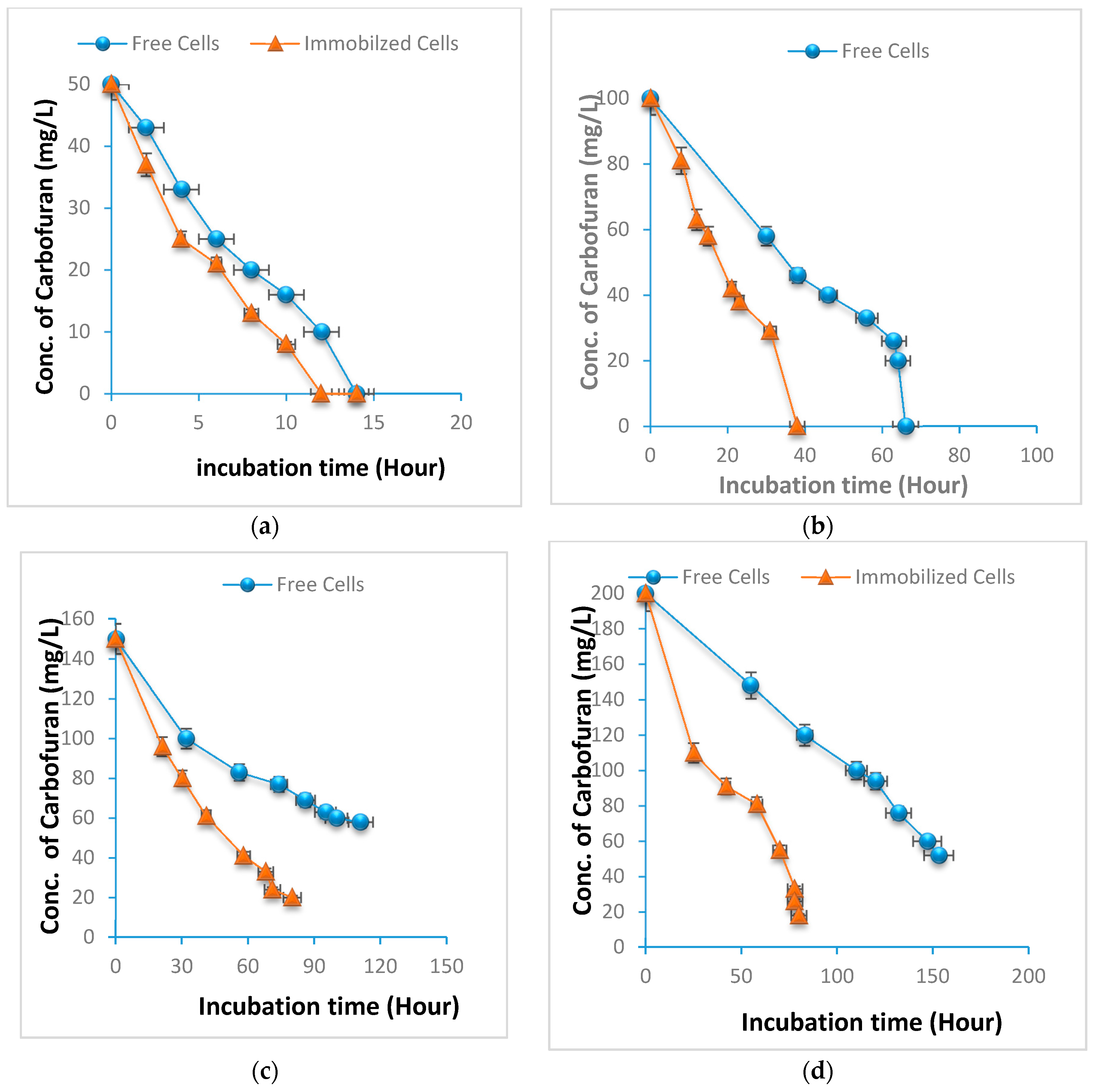
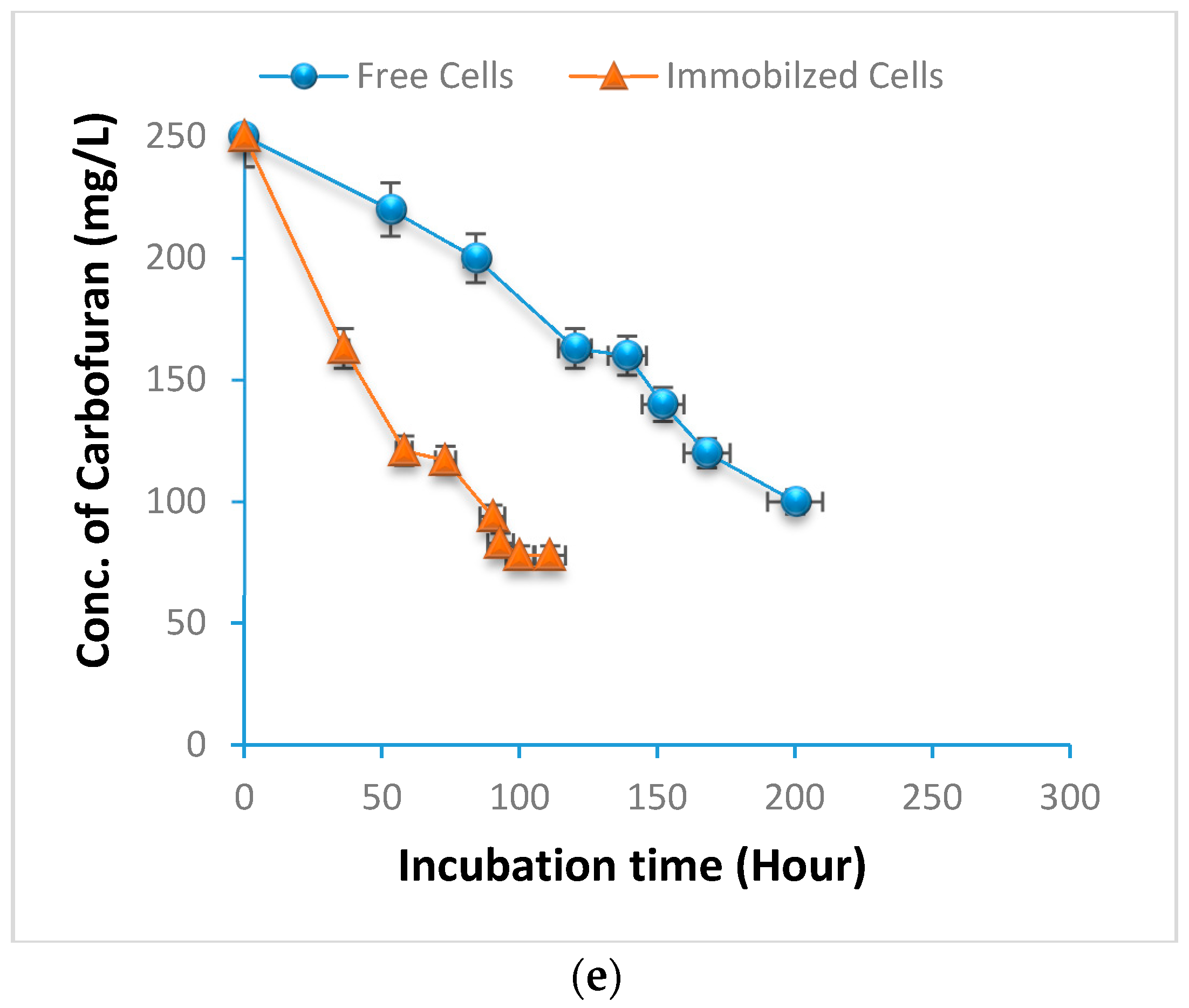
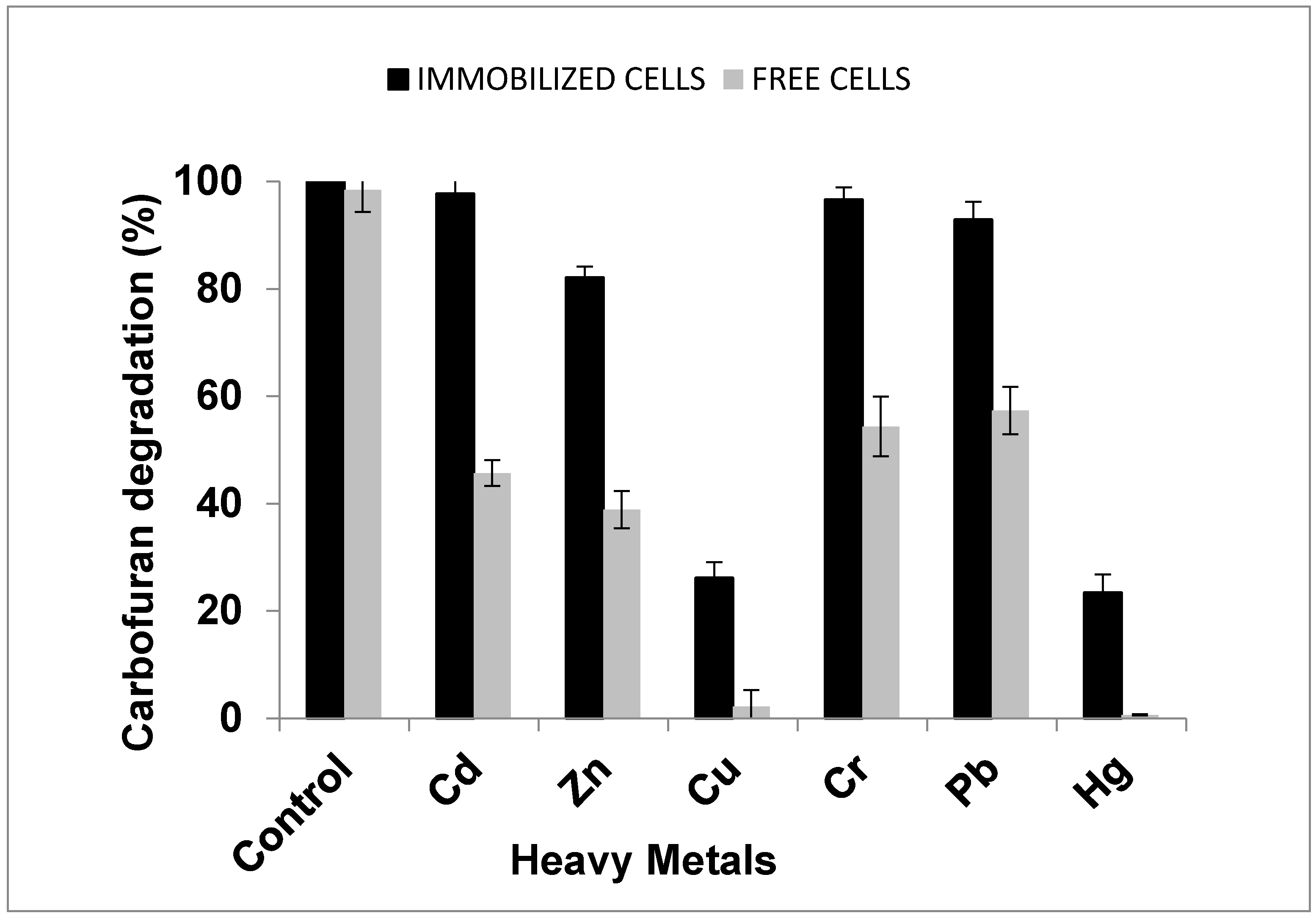
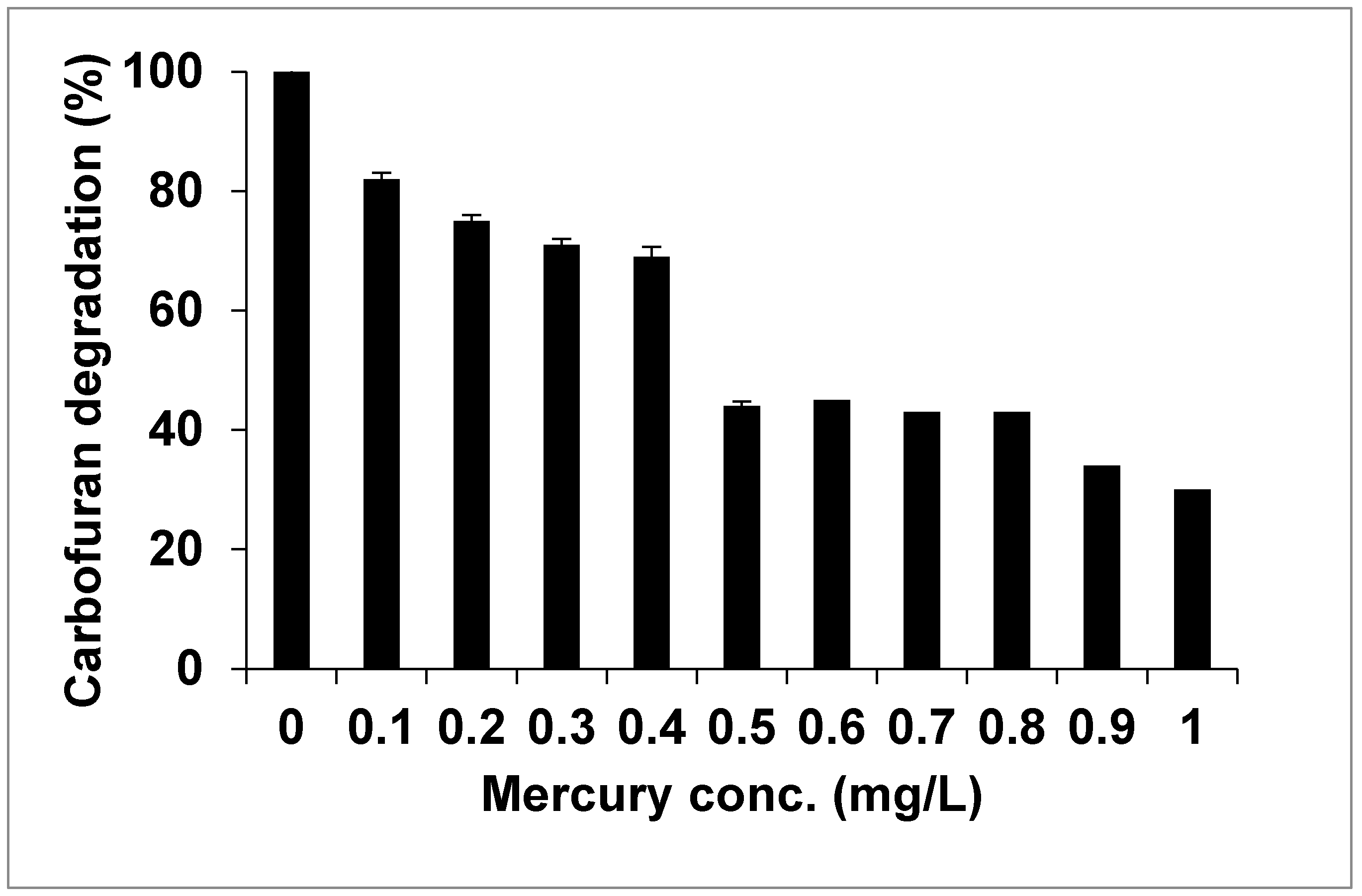
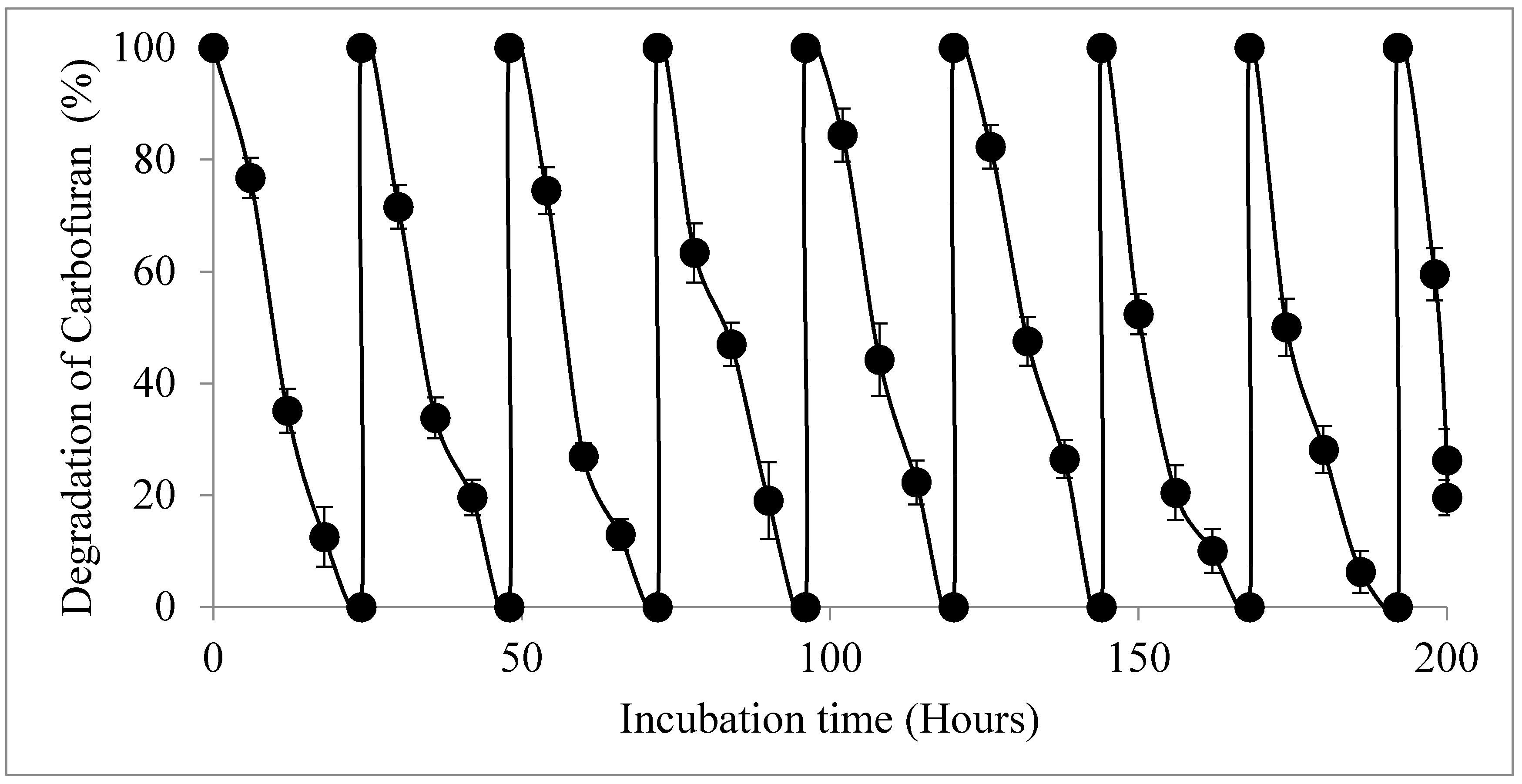
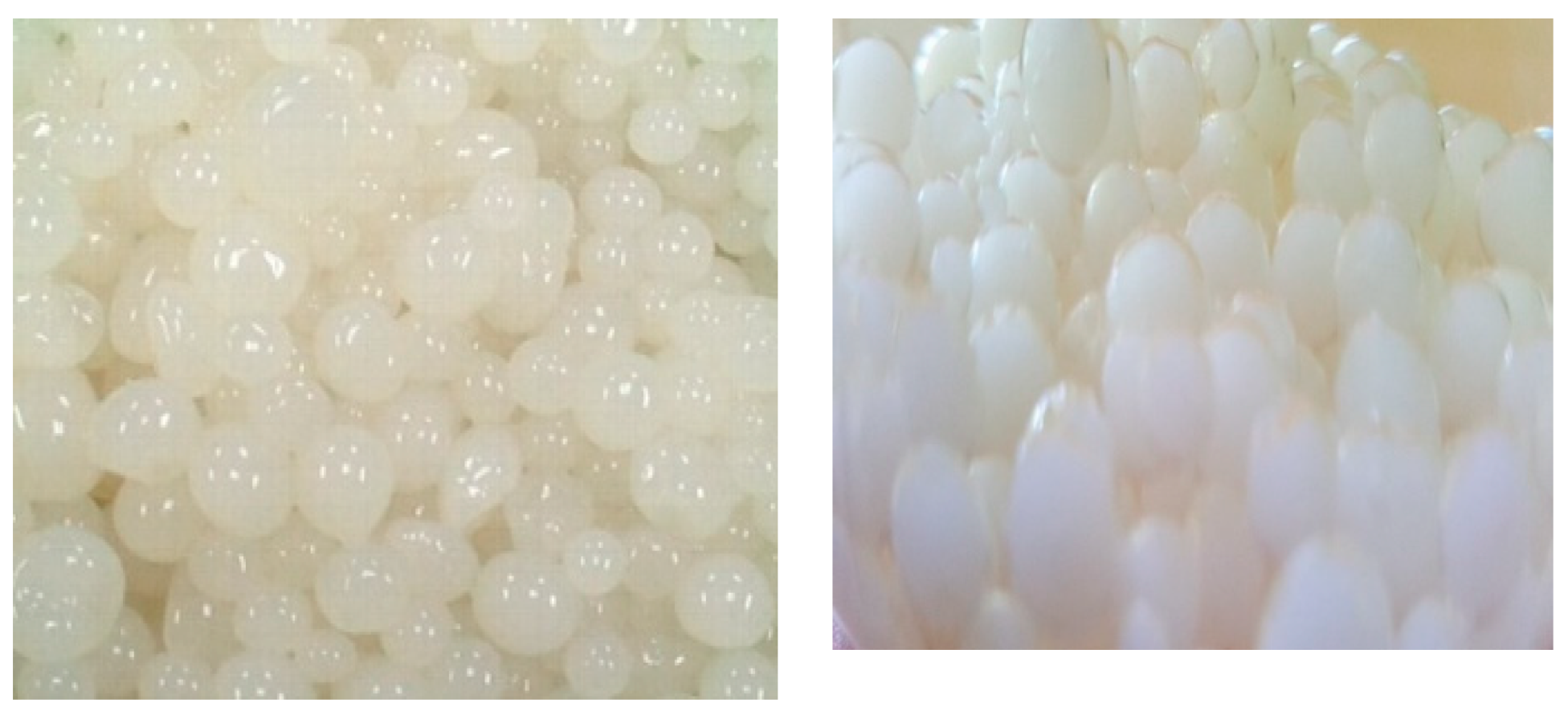
| Description | Max | Total | Query | E | Per. | Accession |
|---|---|---|---|---|---|---|
| Score | Score | Cover | Value | Ident | ||
| Enterobacter cloacae strain PSMK 16S ribosomal RNA gene, partial sequence | 1537 | 2796 | 99% | 0 | 99.64% | MK641315.1 |
| Enterobacter cloacae strain JE3 16S ribosomal RNA gene, partial sequence | 1537 | 2709 | 96% | 0 | 99.64% | KY942149.1 |
| Enterobacter cloacae R11 DNA, complete genome | 1535 | 22072 | 99% | 0 | 99.53% | CP019839.1 |
| Enterobacter sp. pp9c chromosome, complete genome | 1535 | 22253 | 99% | 0 | 99.53% | GQ360072.1 |
| Enterobacter cloacae strain HK196 chromosome, complete genome | 1535 | 22007 | 99% | 0 | 99.53% | CP17087.1 |
| Enterobacter cloacae strain DF3 chromosome complete genome | 1535 | 22072 | 99% | 0 | 99.53% | MG774409.1 |
| Enterobacter sp. PXG11 chromosome, complete genome | 1535 | 22138 | 99% | 0 | 99.53% | JQ396391.1 |
| Enterobacter cloacae strain DMKU-RP206 16S ribosomal RNA gene, partial sequence | 1535 | 2788 | 99% | 0 | 99.53% | MF125281.1 |
| Enterobacter cloacae strain MR1 chromosome, complete genome | 1535 | 22166 | 99% | 0 | 99.53% | KC999878.1 |
| Enterobacter sp. Z-16 chromosome, complete genome | 1535 | 21991 | 99% | 0 | 99.53% | DQ363438.1 |
© 2020 by the authors. Licensee MDPI, Basel, Switzerland. This article is an open access article distributed under the terms and conditions of the Creative Commons Attribution (CC BY) license (http://creativecommons.org/licenses/by/4.0/).
Share and Cite
Umar Mustapha, M.; Halimoon, N.; Wan Johari, W.L.; Abd Shukor, M.Y. Enhanced Carbofuran Degradation Using Immobilized and Free Cells of Enterobacter sp. Isolated from Soil. Molecules 2020, 25, 2771. https://doi.org/10.3390/molecules25122771
Umar Mustapha M, Halimoon N, Wan Johari WL, Abd Shukor MY. Enhanced Carbofuran Degradation Using Immobilized and Free Cells of Enterobacter sp. Isolated from Soil. Molecules. 2020; 25(12):2771. https://doi.org/10.3390/molecules25122771
Chicago/Turabian StyleUmar Mustapha, Mohammed, Normala Halimoon, Wan Lutfi Wan Johari, and Mohd. Yunus Abd Shukor. 2020. "Enhanced Carbofuran Degradation Using Immobilized and Free Cells of Enterobacter sp. Isolated from Soil" Molecules 25, no. 12: 2771. https://doi.org/10.3390/molecules25122771
APA StyleUmar Mustapha, M., Halimoon, N., Wan Johari, W. L., & Abd Shukor, M. Y. (2020). Enhanced Carbofuran Degradation Using Immobilized and Free Cells of Enterobacter sp. Isolated from Soil. Molecules, 25(12), 2771. https://doi.org/10.3390/molecules25122771





